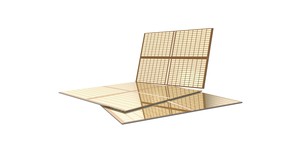
Micron has officially launched its first commercial Phase Change Memory (PCM) product, targeting the smartphone market with a two-chip system that combines both volatile and non-volatile memory.
Micron's PCM is based on glass doped with sulphur, selenium or tellurium to create a material known as chalcogenide glass. This material has a special property missing from normal, undoped glass: when heated, it changes phase and alters its electrical properties. Carefully controlled, these altered phases can be used to store data with up to four states per PCM cell.
The main advantages over traditional dynamic RAM (DRAM) are a reduced power draw and non-volatile storage. Unlike DRAM, PCM doesn't require a refresh cycle - meaning power can be completely removed from the chip without it losing its contents. This makes PCM closer to NAND flash memory than DRAM, but with significantly improved performance - theoretically providing the best of both DRAM and NAND flash technologies.
Built on a 45nm process, Micron's Air PCM packs a 1Gb PCM module into a integrated circuit alongside 512Mb of LPDDR2, providing both non-volatile and volatile storage in a single 1.8V WFBGA package. According to Micron's testing, the module boasts 400MB/s random read performance, code execution without error checking and correction (ECC) on the host processor, endurance of greater than 100,000 write cycles, and requires no erase cycle to alter bits stored in the non-volatile area - a significant performance booster over NAND flash.
Micron claims to be shipping the PCM parts to its customers now, initially targeting the lucrative mobile market with a product that promises to boost battery life and performance. Should the company's PCM parts prove successful in this field, we can expect to see it branching out - and, potentially, becoming the first to market with an affordable, commercially-viable alternative to NAND flash for solid-state storage devices.
Pricing for the parts has yet to be confirmed.
Micron's PCM is based on glass doped with sulphur, selenium or tellurium to create a material known as chalcogenide glass. This material has a special property missing from normal, undoped glass: when heated, it changes phase and alters its electrical properties. Carefully controlled, these altered phases can be used to store data with up to four states per PCM cell.
The main advantages over traditional dynamic RAM (DRAM) are a reduced power draw and non-volatile storage. Unlike DRAM, PCM doesn't require a refresh cycle - meaning power can be completely removed from the chip without it losing its contents. This makes PCM closer to NAND flash memory than DRAM, but with significantly improved performance - theoretically providing the best of both DRAM and NAND flash technologies.
Built on a 45nm process, Micron's Air PCM packs a 1Gb PCM module into a integrated circuit alongside 512Mb of LPDDR2, providing both non-volatile and volatile storage in a single 1.8V WFBGA package. According to Micron's testing, the module boasts 400MB/s random read performance, code execution without error checking and correction (ECC) on the host processor, endurance of greater than 100,000 write cycles, and requires no erase cycle to alter bits stored in the non-volatile area - a significant performance booster over NAND flash.
Micron claims to be shipping the PCM parts to its customers now, initially targeting the lucrative mobile market with a product that promises to boost battery life and performance. Should the company's PCM parts prove successful in this field, we can expect to see it branching out - and, potentially, becoming the first to market with an affordable, commercially-viable alternative to NAND flash for solid-state storage devices.
Pricing for the parts has yet to be confirmed.

MSI MPG Velox 100R Chassis Review
October 14 2021 | 15:04








Want to comment? Please log in.